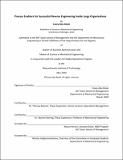Process enablers for successful reverse engineering inside large organizations
Author(s)
Boyle, Casey Alex.
Download1191622598-MIT.pdf (4.720Mb)
Other Contributors
Sloan School of Management.
Massachusetts Institute of Technology. Department of Mechanical Engineering.
Leaders for Global Operations Program.
Advisor
Thomas Roemer, Warren Seering and Daniel Whitney.
Terms of use
Metadata
Show full item recordAbstract
Reverse engineering has the potential to be a strategic advantage for many engineering companies. As companies continuously look for new ways to improve their business and technical expertise, reverse engineering facilitates detailed knowledge capture for many possible applications. These applications open new channels of revenue, create more options in the market, and drive value to customers. Although reverse engineering is nothing new to industry and has been actively researched, this thesis seeks to understand the key enablers that promote successful reverse engineering at scale in a modern corporation. Given that many large firms are set up with the forward engineering process in mind, what are the differentiated characteristics of an effective reverse engineering organization? By treating reverse engineering as a system of interconnected dependent events, an organization can be shaped to build a workflow with the necessary linkages for successful execution and scaling. This "pull" more than "push" process that establishes clear communication between functions is key to preventing rework, shortening flow time, and increasing quality. Reverse engineering, like traditional forward engineering, must be organized as an integrated multifunctional process with organized information sharing, compromise, and iteration. Additionally, the teardown process itself is a central piece of the puzzle for successful reverse engineering. This is due to the multiple strategic linkages associated and interconnectedness required by key stakeholders for understanding the investigated component. A teardown is defined as an observant disassembly of a component for information gain. This thesis focuses more deeply into the teardown process. By showcasing challenges that lead to common errors, teardown process recommendations are made for a more efficient way to reverse engineer. A lack of early stakeholder engagement prior to teardown frequently leads to inefficient knowledge sharing. More active stakeholder participation is recommended to improve the overall quality of teardown reports and serve as an additional opportunity to discover a component's hidden complexities. It is also recommended that formal design tools, such as functional analysis, be utilized for truly understanding a component's physical behavior. Implementing these recommendations and tools will increase the efficiency and output quality of reverse engineering teams, reducing rework.
Description
Thesis: M.B.A., Massachusetts Institute of Technology, Sloan School of Management, in conjunction with the Leaders for Global Operations Program at MIT, May, 2020 Thesis: S.M., Massachusetts Institute of Technology, Department of Mechanical Engineering, in conjunction with the Leaders for Global Operations Program at MIT, May, 2020 "May 2020." Cataloged from the official PDF of thesis. Includes bibliographical references (pages 131-135).
Date issued
2020Department
Sloan School of Management; Massachusetts Institute of Technology. Department of Mechanical Engineering; Leaders for Global Operations ProgramPublisher
Massachusetts Institute of Technology
Keywords
Sloan School of Management., Mechanical Engineering., Leaders for Global Operations Program.